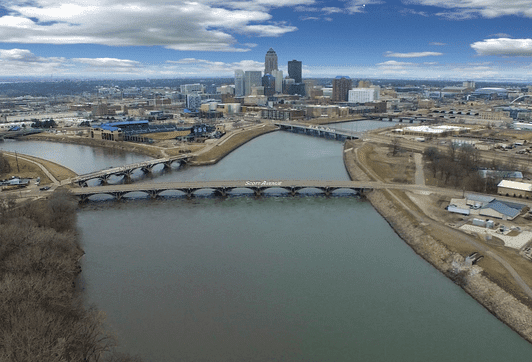

Many people are curious about Iowa stream nitrate before modern agriculture became established across the landscape. They want to know what the “natural” level of nitrate was. It turns out we do have some actual data. In 1955, the Iowa Geological Survey published a document titled “Water-Supply Bulletin No. 5, Quality of Surface Waters of Iowa, 1886-1954” (1). Some of these data are shown below (as nitrogen).
Confluence of the Des Moines (right) and Raccoon (left) Rivers
Nitrate concentrations in these streams over the past 30 years or so average 5-8 mg/L, with the Raccoon averaging greater than 10 mg/L in the worst years, so roughly a 10-fold increase from a century ago and a 3- to 4-fold increase since 1950. Loads, or the total mass of nitrate transported by these rivers, have increased far more because stream discharge has increased 2-3 times across Iowa over the past century, and loads are the product of discharge and concentration.
So, what exactly happened?
Although commercial fertilizers (inorganic formulations of nitrogen such as anhydrous ammonia, nitrate salts, urea, urea ammonium nitrate (UAN), ammonium phosphates) were not widely used until the 1960s, the process of “breaking the prairie” and “opening up the land” for crop production, along with the first wave of tile drainage, did release nitrogen into […]
Full article: This is what happened
Clean water is essential for life, yet millions of Americans unknowingly consume contaminants through their…
Human brains contain higher concentrations of microplastics than other organs, according to a new study, and the…
From the Office of the Governor: In anticipation of a multi-day, significant atmospheric river in Northern California,…
From Governor Newsom: Scientists, water managers, state leaders, and experts throughout the state are calling…
Photo: A harmful algal bloom in Milford Lake, Kansas, made the water appear bright green.…
An expanded plastic foam coffee cup is at a donut shop in Monterey Park, California.…